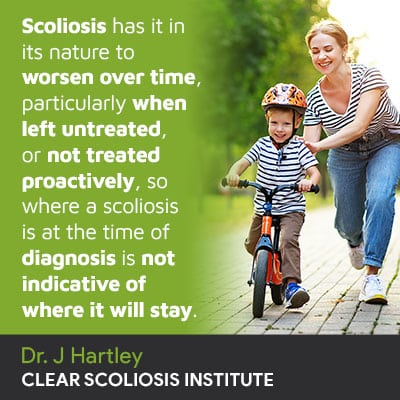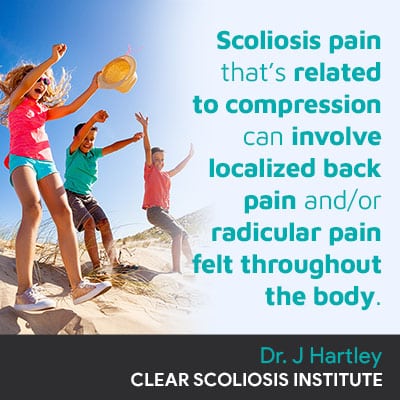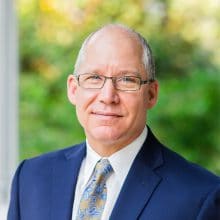
Scoliosis ranges widely in severity from mild to severe, and in most cases, the more severe the condition, the more noticeable its symptoms are. When it comes to pain, adults and adolescents experience scoliosis pain very differently. Continue reading to learn more about the nature of scoliosis pain, including symptoms and pain-relief options.
Scoliosis pain is different for children and adults, and this is mainly due to growth and development. Once scoliosis becomes compressive in adulthood, the spine, and its surrounding muscles and nerves, are vulnerable to compression: the main cause of condition-related pain.
Before getting to the specifics of scoliosis pain, let’s explore its underlying cause: the condition itself.
Scoliosis is a structural spinal condition that causes a loss of the spine’s healthy curves. The condition involves the development of an unnatural sideways spinal curve, with rotation.
It’s the rotational component that makes scoliosis a 3-dimensional condition as the spine doesn't just bend unnaturally to the side, but also twists from back to front, front to back.
The unnatural curve also has to be of a minimum size to fulfill the parameters of a scoliosis diagnosis: Cobb angle of 10+ degrees.
A patient’s Cobb angle is a measurement taken during X-ray that involves drawing lines from the tops and bottoms of the curve’s most-tilted vertebrae; the resulting angle is expressed in degrees, tells me how far out of alignment the scoliotic spine is, and further classifies the condition in terms of severity:

Scoliosis has it in its nature to worsen over time, particularly when left untreated, or not treated proactively, so where a scoliosis is at the time of diagnosis is not indicative of where it will stay.
Even a patient diagnosed with mild scoliosis can easily progress to moderate or severe, which is why an important part of treatment is working towards counteracting the condition’s progressive nature.
So now that we’ve discussed the parameters that have to be met to reach a scoliosis diagnosis, and the connection between condition severity and symptoms, let’s move on to exploring the nature of scoliosis pain.
The spine’s natural curves make it stronger, more flexible, and better able to absorb stress, like a coiled spring.
When the spine loses one or more of its healthy curves, the biomechanics of the entire spine are disrupted, with the potential to affect its overall function and health, and this introduces a lot of uneven forces to the body.
In addition, the brain and spine work together to form the body’s central nervous system (CNS), which facilitates brain-body communication.
As the CNS is involved in virtually every working system within the body, spinal conditions like scoliosis can cause a wide variety of symptoms felt throughout the body.
As mentioned earlier, when it comes to scoliosis pain, adolescents and adults experience it very differently, and this is due to skeletal maturity.
Adolescent idiopathic scoliosis (AIS), diagnosed between the ages of 10 and 18, is the condition’s most-prevalent form, and while approximately 20 percent of adolescents do report experiencing muscle pain, when it comes to back and radicular pain, it isn’t commonly part of the AIS experience.
While a body is growing, the spine is undergoing a constant lengthening motion, and that counteracts the compressive force of the curve; it’s compression of the spine, and its surrounding muscles and nerves, that causes the majority of condition-related pain.
For children and adolescents, the most noticeable symptoms of scoliosis are related to how the condition disrupts the body’s overall symmetry; postural deviation such as uneven shoulders and hips are often the earliest signs of the condition.
So for adolescents, the lack of pain can be a challenge to reaching early detection, but for adults, pain is the number-one symptom that brings them in for a diagnosis and treatment.
Scoliosis pain that’s related to compression can involve localized back pain or radicular pain felt throughout the body.
When it comes to my adult patients, it’s most often radicular pain felt in the arms, legs, and feet that brings them in to see me.

When people with scoliosis are asked to describe their scoliosis pain, descriptions tend to include feeling pulled to one side, feeling weighed down, and feelings of tight, sore, and strained back muscles.
Depending on the degree of nerve involvement, and where the compressed nerve is located, when a spinal nerve is exposed to uneven pressure, pain can be felt anywhere along the nerve’s pathway: tingling sensations, sensations of numbness, weakness, and/or electric shock-like shooting pains.
For example, in cases of lumbar scoliosis, a common complication is sciatica as the sciatic nerve starts in the lower back; when the lower back has an unnatural spinal curve, the uneven pressure can irritate, compress, or impinge the sciatic nerve.
Muscle pain is a common symptom of scoliosis, regardless of age, as it’s not just the spine that’s charged with maintaining its natural curvatures and alignment, but also its surrounding muscles that provide crucial support.
In addition to back, radicular, or muscle pain, headaches with the potential of reaching migraine status can also be an issue for people living with scoliosis; this is related to a disruption in the flow of CSF fluid in the spine, affecting levels in and around the brain.
So now that we’ve talked about the condition itself, what causes scoliosis pain, and some common scoliosis pain symptoms, let’s address treatment options.
When it comes to the best scoliosis pain relief options, as a CLEAR-certified scoliosis chiropractor, I believe in the merits of proactive treatment that impacts the condition, first and foremost, on a structural level.
By working towards a curvature reduction and increasing core strength so the spine is optimally supported and stabilized, scoliosis symptoms, like postural deviation and pain, are being addressed because their underlying cause, the condition itself, is being treated.
There is a big difference between treating pain as a symptom, or treating the condition itself: the pain’s underlying cause.
By combining multiple condition-specific treatment disciplines, I can work towards impacting scoliosis on every level.
Chiropractic care involves a variety of techniques and manual adjustments to work towards repositioning the most-tilted vertebrae of the curve back into alignment with the rest of the spine.
Through a variety of therapies, I can help patients increase core strength so their spines are optimally supported, and in addition, certain scoliosis-specific exercises (SSEs) are known to activate specific areas of the brain for improved brain-body communication, postural remodeling, and better body positioning.
When scoliosis bracing is needed, the ultra-corrective ScoliBrace is our brace of choice as it represents the culmination of what we’ve learned about bracing efficacy over the years, and it complements other forms of treatment by augmenting corrective results.
Custom-prescribed home exercises can be part of establishing a home-rehabilitation program for further stabilizing the spine for sustainable long-term results.
As such a highly-variable condition that can range from mild to severe, no two patients will experience their condition in the exact same way, which is why the nature of scoliosis necessitates the customization of effective treatment plans.
As the spine is involved in virtually every working system within the body, spinal conditions like scoliosis can cause a wide range of effects felt throughout the body.
When it comes to scoliosis pain, it can involve more than just the back, and for adults, back and radicular pain is the most common scoliosis symptom, whereas in children and adolescents who are still growing, postural deviation is the condition’s main visual symptom.
Scoliosis can also cause various levels of muscle pain as the muscles surrounding the spine struggle to support the unnaturally-curved spine.
In addition to back pain, nerve pain, and muscle pain, scoliosis can also be associated with debilitating headaches due to a disruption in the flow of cerebrospinal fluid.
When it comes to scoliosis pain relief, the best option is proactive treatment that addresses the underlying cause of the pain: the condition itself.
Regardless of age or condition severity, as a progressive condition, the best time to start scoliosis treatment is always now; that way, increasing condition severity, escalating symptoms, and the need for more-invasive treatment in the future can be avoided.
For patients interested in a modern conservative scoliosis treatment approach, the CLEAR Scoliosis Institute has helped 95 percent of its patients improve their condition non-surgically.

CLEAR provides a unique and innovative way of understanding scoliosis. Sign up to receive facts and information you won’t find anywhere else.
